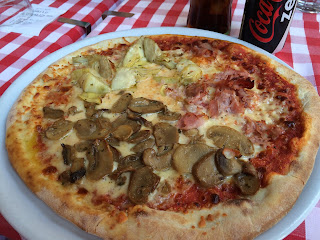 |
| Pizza Capriciossa |
It's Friday. I'm tired (not lazy as if I were lazy, I would not be writing this at all). I need to get up early to catch the train to Rome in the morning (You may remember someone in this place wants to hit the Eternal City tomorrow. Being ever so accommodating, I agreed even though I swore I wasn't going back this trip. Yes. Yes. I know you've heard that before.)
At any rate, since I'm tired, it's Friday, and i haven't done food in a few weeks, I thought I'd show you some of the pizzas I've had this trip. I had them all at different places, and they were all very good. I can't name a favorite among them, but I can tell you I've found a new kind to order—capricciosa.
I've had capricciosa twice this trip, and they were a little different each time. Capricciosa usually has mozzarella cheese, baked ham, mushrooms, artichokes and tomato. Some places put olives on theirs (above), while others don't (last photo below). I prefer the ones with olives, but they're both good.
 |
| Pizza Margherita |
Mike ordered pizza margherita the other day, and unlike the pizza margherita we know in the States—olive oil, fresh tomatoes, mozzarella (or provolone), and basil, magherita pizza in Italy is tomato sauce and cheese (above). The one we had in Ravenna had a lot of cheese on it, so Mike was happy.
 |
| Pizza Quattro Stagioni |
You probably noticed that quattro stagioni and capricciosa are have almost identical ingredients. The difference is in the presentation in that the ingredients all cover the capricciosa pizza while each ingredient covers a quarter of the quattro stagioni pizza.
 |
| Pizza bianca |
I've seen dozens of takes on pizza bianca here. Some places offer it with exactly the same toppings as regular pizza sans the tomatoes and/or tomato sauce. Others offer it with a white cream sauce on it. I've even seen it with roasted potatoes and ham on it. (Carb alert)
 |
| Pizza Capricciosa (front) and Pizza Napoletana (left rear) |
Just as an aside, I've never had pizza with thick crust in Italy, and I've never been in a restaurant certified by the AVPN.
I'll be on the lookout in Rome (hot, crowded, dirty) tomorrow.

No comments:
Post a Comment